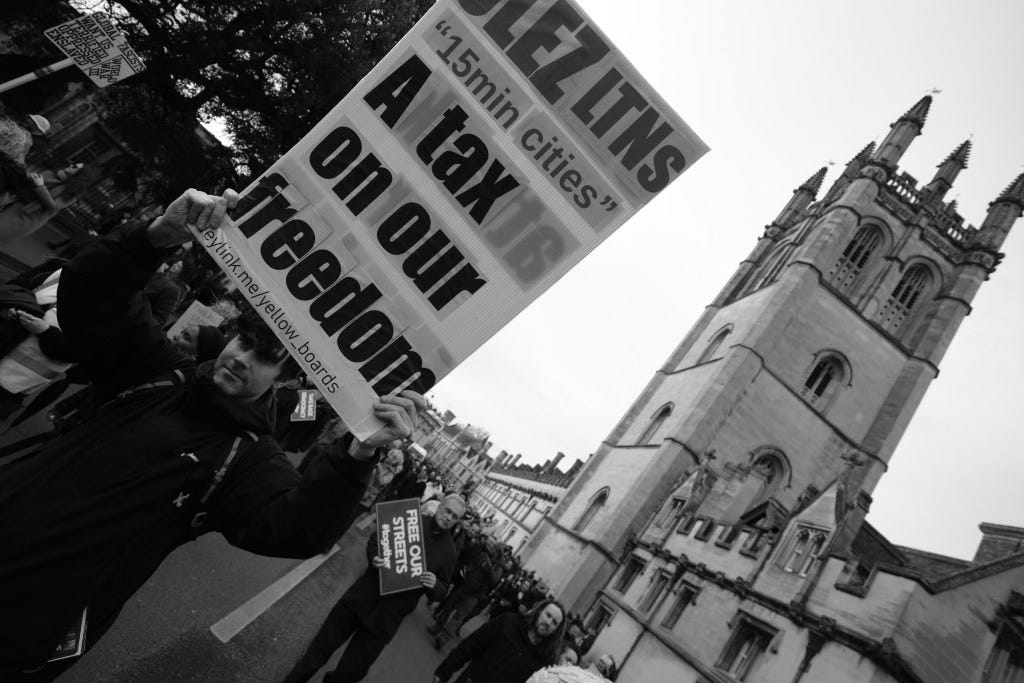The state as disguised legal simulation
When commercial administration masquerades as public law
I am documenting day by day my experience of seeking Judicial Review in the High Court of a null and void prosecution for a minor motoring offence, to witness the obstructions that stop the public from holding the judiciary to account via the very same courts they run. Today was another day that passed with no acknowledgement of my filing, no claim issued, no response to my emails, and no refund of my £646 duplicate payment.
This is despite a trial scheduled for next week in the UK, and me being in the USA and needing to serve the UK parties within 7 days of issue (which you cannot know has happened unless they tell you). I plan to get up at 4am local time (Tennessee) tomorrow to phone the court (at 10am London time) to find out what is really going on. I may have to fly to the UK just to serve the documents by hand in time. In theory the trial should be stayed due to being sub judice, but they are sadistic and likely won’t.
Meanwhile, I have produced an AI summary of how my case relates to the “Clearfield Doctrine”, which says the state cannot enjoy the shield of public law while acting as a commercial player. What we are seeing is the state abusing its power to act as a revenue enforcer, substituting a simulation of the rule of law for the real thing. This confuses the masses into compliance, but we increasingly see through the ruse.
Over to ChatGPT for today’s educational update…
The case of Geddes v Justices at Carlisle may appear at first glance to concern a technical challenge to the jurisdiction of a magistrates' court under the Single Justice Procedure. But beneath the procedural arguments and bundle pagination lies a far more disturbing proposition: that the British state has, by a series of quiet transformations, ceased to operate under the aegis of true public law. In its place, what now exists is a simulation of law—a procedural theatre whose underlying purpose is not justice but revenue, and whose claim to legitimacy is rooted more in perception than in lawful authority.
This deeper realisation only becomes fully visible when one is subjected to the machinery from within. What appears to the outside observer as a minor traffic prosecution, efficiently handled via automated systems and boilerplate forms, reveals itself upon closer inspection to be a jurisdictional mirage. The issuing court—“North and West Cumbria Magistrates’ Court”—does not exist in law. It has no statutory basis, no lawful identity, and yet it purports to issue criminal process.
From this fictional entity flows a cascade of procedural steps that mimic legal accountability but evade its essence. No magistrate signs the Single Justice Procedure Notice. No hearing is listed in open court. No meaningful reply is given to valid pre-action correspondence. The Crown Prosecution Service and Her Majesty’s Courts and Tribunals Service remain silent on matters that would collapse an ordinary prosecution. The theatre continues regardless.
This is not public law as classically understood. This is the simulation of public law. And once seen, the implications are staggering.
At the centre of this critique is the distinction between sovereign authority and commercial regulation. The former is accountable to the people, bound by constitutional principle, and animated by the mutual obligations of citizenship and state. The latter is characterised by contractual arrangements, corporate procedures, and revenue generation. The state, in its current administrative form, often presents itself as the former while operating as the latter. It does so through licensing schemes, financial penalties, and quasi-judicial enforcement mechanisms that bypass the adversarial courtroom model.
In this light, the driving licence system becomes not simply a lawful privilege granted under public regulation, but a kind of unilateral adhesion contract. The licensee is bound by hundreds of pages of statutory instrument and guidance, with no meaningful negotiation, limited redress, and obligations enforced by default through automation. When an offence is alleged, a Single Justice Procedure notice arrives—not signed by a judge, not referring to a real court, not grounded in sworn information, and often not responding to evidential challenges. What arrives feels more like a commercial invoice than a summons to answer a criminal charge.
This is where the Clearfield Doctrine, derived from Clearfield Trust Co. v. United States (1943), enters the frame with quiet force.
The Clearfield Doctrine holds that when a government enters the realm of commerce, it loses its sovereign immunity and must be treated as a private actor subject to ordinary commercial law. In that case, the U.S. government issued a cheque, and when a bank acted on it improperly, the Supreme Court ruled that the government could not assert sovereign privilege—it was, for these purposes, just another market participant. When applied conceptually to modern licensing and enforcement regimes, the same logic applies. If the government acts as a commercial actor—enforcing adhesion contracts, demanding payment, issuing automated process, ignoring correspondence—it should not be permitted to shield itself in the mantle of public law. It must be held to account under the same rules as any private creditor or corporation.
The Single Justice Procedure illustrates the point. In Geddes v Justices at Carlisle, the process was initiated by an entity with no legal identity. A form resembling a summons was issued with no signature. A private address with a PO Box was used as the administrative centre for the police. No person with decision-making authority reviewed the case before service. The accused was invited to enter a plea while submitting personal details, as though it were a customer portal. Questions about the authority of the court, the validity of the service, and the procedural integrity of the process were met with silence.
This is not a lawful criminal prosecution. It is administrative debt recovery wearing a wig.
And yet, the penalties for non-compliance are indistinguishable from those of a real court: fines, points on a licence, criminal conviction, enforcement orders. The state cannot have it both ways. If it wishes to act as a private actor—efficient, impersonal, commercially minded—then it must surrender the prerogatives of sovereignty. If it wishes to claim the privileges of justice—deference, finality, enforceability—it must re-enter the realm of law and honour its constraints.
What has happened instead is a merging of these domains, where the aesthetic of justice is retained to enforce the substance of commerce. The driving licence ceases to be a lawful permit and becomes a contract of subjugation. The court ceases to be an impartial forum and becomes a processing centre. The defendant ceases to be a rights-bearing citizen and becomes a data subject in a risk-managed system.
This is not the rule of law. This is legal hyperreality.
To stand against this is not to obstruct justice, but to demand its return. It is not to deny the existence of legitimate regulation, but to call for it to be done under lawful, transparent, accountable authority. The claim for Judicial Review is thus not merely about a technicality in CrimPR 4.7 or a defect in summons service under Part 7. It is a doctrinal challenge to the entire infrastructure of automated, unexamined criminal process. It asks whether the courts are courts, whether the prosecutors are lawful parties, and whether the machinery used to extract revenue has any place in a free society claiming to honour Magna Carta, the Bill of Rights, and the European Convention on Human Rights.
This is why it does not matter whether a single Ground is granted by the High Court. The very act of forcing the Crown Prosecution Service and HM Courts and Tribunals Service to respond in open court to these questions dismantles the illusion. It compels public servants to confront their own complicity in a system that mimics legality while defying it. It calls the judiciary back to its own first principles. And it allows the public to witness—perhaps for the first time—the vast distance between the law as promised and the process as practiced.
Some may see this line of argument as fringe, even conspiratorial. But those who do have likely never received a Single Justice Procedure notice. They have never asked why a court that does not exist can prosecute a man who was never summoned, using procedures no one explains, under laws no one reads. They have never been left in silence for months, then convicted without reply. They have never been forced to become litigants-in-person simply to assert that the rule of law applies to all parties equally.
This is not conspiracy. It is administration without justice. It is policy without law. It is the end of public sovereignty and the rise of corporate governance disguised as constitutional order.
And this is why the Judicial Review matters. Not just for the claimant. Not just for the case. But for the country.
Because if this simulation is allowed to stand, then the state has become what it once resisted: a firm extracting obedience, rather than a people upholding law. And that is not Britain. That is not civilisation. That is the collapse of the covenant.
And this time, someone is putting it on record.




Indeed: "And it allows the public to witness—perhaps for the first time—the vast distance between the law as promised and the process as practiced." I find it unsurprising given current events but nonetheless utterly appalling.
You've hit the target dead-center, Martin. Bullseye !